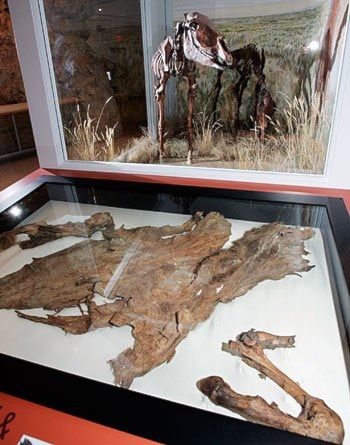Midway through the last ice age, a prehistoric horse ended its life in muddy ignominy.
Twenty-six thousand years later, the horse’s tattered skin, which resembles beef jerky, has become a Yukon treasure.
Last Monday, officials at the Yukon Beringia Interpretive Centre proudly unveiled the preserved hide, discovered 16 years ago in permafrost outside Dawson City.
For the young Beringia Centre, the hide represents the museum’s first major “real” artifact.
“The things we do have are all casts and replicas—or a mammoth leg bone here and there,” said acting manager Stacie Zaychuk.
In 1993, placer miners Lee Olynyk and Ron Toewes were working a claim at Last Chance Creek when an unbelievable stench hit their nostrils.
“Most placer mines stink to begin with, but when you start finding melting 30,000-year-old flesh, it really stinks,” said Yukon paleontologist Grant Zazula.
Olynyk’s son, Sam, soon noticed the source of the pungent aroma; emerging out of the side of the thawing soil were the tattered remains of a prehistoric horse.
Yukon archaeologists Ruth Gotthardt and Greg Hare were on the scene within days.
The smelly bundle of prehistoric skin and hair was recovered, crated and shipped off to a laboratory in Ottawa where it was carefully unfolded and preserved to museum quality.
The hide is Canada’s best-preserved specimen of a “freeze-dried” extinct large mammal.
“It’s like if you left a steak in the freezer for 25,000 years,” said Zazula.
Nobody knows exactly how the Last Chance Creek horse died—but scientists did find a lot of hair in the animal’s stomach.
“Often, when an animal is injured, they will lick a wound, so we think it was wounded, maybe got wallowed down in some mud and died,” said Zazula.
Nearby wolves then took a few bites from the downed horse, as evidenced by some teeth marks on the edge of the hide.
When spring came, scientists suppose that the horse was buried by a mudslide.
Before the end of the last ice age, Yukon horses roamed all across the sparse grasslands of Beringia.
Unlike their modern counterparts, these early horses were about the size of ponies.
With the end of the ice age, the death knell was soon sounded for the Yukon horse.
As it got warmer, it also got wetter—and the horse’s beloved grasslands were replaced by boggy tundra.
The horse’s tiny hooves got mired in the deep muck.
Meanwhile, grasses were replaced by leafier birches and shrubs—both inedible to horses.
And for humans arriving from the Bering land bridge, a bunch of half-starved horses slogging through mud must have proved easy targets.
(Caribou, were doing great at the end of the ice age. Gorging on shrubs and greens, the ungulates had more than enough energy to outrun human spears.)
North America would remain horse-free until the 16th century, when some Spanish horses got loose from the reins of South American conquistadors.
By the time European explorers found their way to the North American plains, they encountered herds of wild European horses.
As freeze-dried carcasses go, Canada is relatively poor.
In Alaska, a complete 36,000-year-old bison was discovered in 1979 at a gold mine outside of Fairbanks. Scientists dubbed it Blue Babe, after Paul Bunyon’s ox sidekick.
Siberia, favored with much colder permafrost, has long been regarded as a treasure trove of freeze-dried prehistoric animals.
In 2007, reindeer herders in Siberia came upon a completely intact baby mammoth.
Even if Canadian permafrost can’t promise the prehistoric bounties of Russian permafrost, Canadian finds attract the most scientific attention.
With everything “legitimate and above board,” world-renowned scientists can examine Canada’s freeze-dried animals without needing to stoop to “dodgy politics.”
Yukon researchers have contact with scientists ranging everywhere from Copenhagen to Australia to Pennsylvania State University.
“They would rather work with us because they’re not having to do backdoor dealing with Russian mobsters,” said Zazula.
Becoming sandwiched amid permafrost remains one of nature’s most effective ways of preserving soft tissue for millennia.
Natural freeze-drying is so effective that it has been known to preserve prehistoric remains to the point of being edible.
Stories abound of half-starved gold rush miners eating mammoth flesh to survive.
Alaskan researchers celebrated the successful recovery of Blue Babe with a feast of prehistoric bison stew.
No part of the Last Chance Creek horse has been eaten.
Contact Tristin Hopper at
tristinh@yukon-news.com
